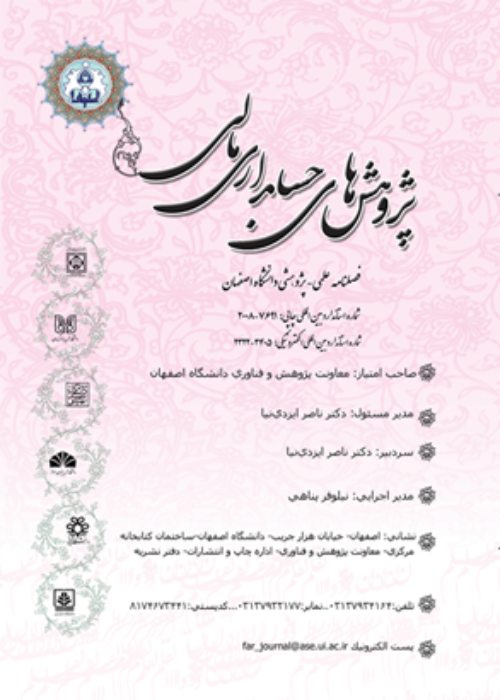Presenting an Integrated Model of Demetel Method and Fuzzy Hierarchical Analysis Process to Identify and Prioritize the Factors Affecting the Quality of Financial information in the Public Sector Based on the Grounded Theory Approach
The main purpose of this study was to present an integrated model of Dimtel method and fuzzy hierarchical analysis process in order to identify and prioritize the factors affecting the quality of financial information in the Iranian public sector using the grounded theory approach. The present study was of applied and exploratory type. To determine the sample size, the snowball method was utilized, based on which the statistical sample size of 70 people was considered. To achieve the research objectives, the questions to be designed for the interviews and finally the 5 structural factors of environment, process, output, outcome, and sub-component related to each factor were identified as effective factors in financial information quality based on the grounded theory approach. Then, the combined model, fuzzy hierarchical analysis, and fuzzy Dimtel were applied to prioritize, determine the impact intensity and effectiveness, and draw a causal diagram between the components. The results showed that among the main factors of the research, the structural factor gained the highest rank and the factor of process was the least important factor in the quality of financial information in the public sector.
The expansion of the duties, activities and programs of the governments has caused the use of a coherent and integrated government accounting and financial reporting information system to carry out public sector financial affairs and make logical and useful decisions to achieve organizational goals and fulfill the responsibility of accountability. Therefore, in recent years, there have been many developments in the accounting and financial reporting system of the public sector in developed and sometimes developing countries.
In this regard, in recent years, in Iran, due to the growing economic, social, and cultural environment and the communication of the general strategies of the twenty-year vision document and the fourth and fifth programs of the country's economic, social, and cultural development, and following that, changing the budgeting system from a program The need to calculate the cost of government services and activities, the need to make fundamental changes in the accounting and financial reporting system of the public sector is clearly felt; Therefore, measures have recently been taken in the field of reforming the country's financial system, the turning point of which is the formulation of accounting standards for the public sector and the theoretical concepts of public sector financial reporting, which became effective at the beginning of 2014 (Kazazi, 2005).
In fact, providing high-quality information about public sector activities by using the optimal public sector accounting system increases the usefulness of the information provided in financial reports for users and makes it possible to achieve the goals of financial reporting, including accountability and decision-making (Kordestani and Nasiri, 2018). Obviously, the implementation of a high-quality financial reporting system in the public sector will be accompanied by serious obstacles and challenges in the early years; Therefore, it is essential to identify obstacles, challenges and factors affecting the quality of financial reporting in the public sector.
Therefore, in this research, an attempt was made to provide a more comprehensive criterion by using more observable criteria of the quality of public sector financial reporting, which also have theoretical support, and to answer the following question:What are the factors affecting the quality of financial reporting in the public sector?
Methods & Material:
The present research method is of mixed type. The mixed research approach is a type of research method in which the researcher combines the elements of quantitative and qualitative approaches in order to reveal the existing obstacles and deeply understand the phenomena. In order for the combination of two approaches (quantitative and qualitative) to take place in the most effective way, the researcher must combine different data in such a way that not only they do not overlap, but in the results, the strengths are strengthened and the weaknesses are eliminated (Mohammadi et al., 2019).
In the qualitative part of the research, first the indicators are identified through interviews and using the method of grounded theory. In this section, the aim is to identify the components related to the quality of financial information of the public sector and extract the relevant categories.
In the quantitative part of the research, the relationships between the categories and indicators obtained from the qualitative part are analyzed by the combined method of fuzzy hierarchical analysis and Fuzzy Dimetal technique 4. In this way, the fuzzy hierarchical analysis process approach was used to prioritize the quality components of public sector financial information, and finally, by using the fuzzy Dimetal model, the cause-effect diagram between the components was presented.
In the grounded theory method, after collecting the interview and textual data, analysis and coding have been done in three stages of open, central and selective coding; Therefore, in this research, based on the grounded theory method and after performing the steps of open, central and selective coding, the factors extracted from library sources, literature review and collective opinion of experts were categorized into 5 structural factors, environment, processes, output and consequences.
The results of the combination of two methods, fuzzy hierarchy and fuzzy Dimethal, are presented in Table 7. According to the results of Table 7, the order and prioritization of the mentioned factors are as follows. In the structural factor, the infrastructure component in the public sector has the highest weight in the hierarchical analysis, and it also has the highest rank in the fuzzy Dimetal method and is in maximum interaction with other components; Therefore, due to its greater effectiveness, it is considered a disabled criterion. In the environmental factor, the component of technological changes has the highest weight in the hierarchical analysis, and it has the highest rank in the Fuzzy Dimetal method and is in the maximum interaction with other components; Therefore, due to its greater effectiveness, it is considered a disabled criterion. In the factor of processes, the component of not fully implementing operational budgeting has the highest weight in the hierarchical analysis, and in the Fuzzy Dimtel method, it interacts with other components in a low way and ranks twelfth; But due to its greater impact on other components, it is considered causal. In the output factor, the quick response component has the highest weight in the hierarchical analysis and the highest rank in the fuzzy Dimetal method, which shows that this component has the most interaction with other components and is considered a causal criterion due to its high impact on other components. In the effect factor, the component of selecting capable managers is in the first rank of the hierarchical analysis, and it has the highest rank compared to other components in the Fuzzy Dimtel method, and it is more effective than other components; Therefore, it is considered a disabled criterion.
In order to achieve the goals of the research, first the research literature has been reviewed and the questions for the interview have been designed. Then, using the grounded theory method, 5 structural, environmental, processes, output and consequence categories and their sub-components were identified as factors affecting the quality of public sector financial information. Further, considering the importance of the issue and determining the importance of each of the factors affecting the quality of financial information of the public sector, this research prioritized the mentioned factors with the approach of fuzzy hierarchical analysis. The final result of prioritization showed that the process factor is the least important factor in the quality of financial information in the public sector, and structural factors have been determined as the most important factor in the quality of financial information. This result shows that the structures of the public sector are currently not desirable in Iran and have problems and ambiguities.
The combination of the results of the combination of fuzzy hierarchical analysis and fuzzy Dimetal showed that among the structural factors, the infrastructure component in the public sector has the highest weight and rank in the hierarchical analysis and fuzzy Dimetal method. This result indicates that from the point of view of the respondents, infrastructure is necessary and important to achieve high-quality financial reporting in the public sector. In the environmental factor, the component of technology changes has the highest weight and rank in hierarchical analysis and fuzzy Dimetal method. The significant development of information technology and its benefits make a lot of information available through the public database, especially the Internet, and as a result, decision makers can increasingly use more timely and relevant information to make decisions. This interpretation is in line with the result that from the point of view of the respondents, the component of technological changes has the highest rank among the environmental factors. In the factor of processes, the complete non-implementation of operational budgeting has the highest weight in the hierarchical analysis and in the Fuzzy Dimtel method, it has a low interaction, which shows that this component has a strong interaction with other components and is considered a causal criterion due to its high impact on other components.
In the output factor, the component of quick response from the point of view of the respondents is in the first rank of hierarchical analysis and fuzzy Dimetal method. Based on the strategies proposed by the respondents to improve the quality of financial reporting, it is expected that this strategy (accountability) will bring the highest result for the quality of financial reporting of the public sector. Obviously, from the point of view of the respondents, the existence of high-quality financial information in democratic systems plays a major role in fulfilling the government's duty as public accountability; Because it is used as a tool to evaluate accountability and make economic, social and political decisions by people.
- حق عضویت دریافتی صرف حمایت از نشریات عضو و نگهداری، تکمیل و توسعه مگیران میشود.
- پرداخت حق اشتراک و دانلود مقالات اجازه بازنشر آن در سایر رسانههای چاپی و دیجیتال را به کاربر نمیدهد.




